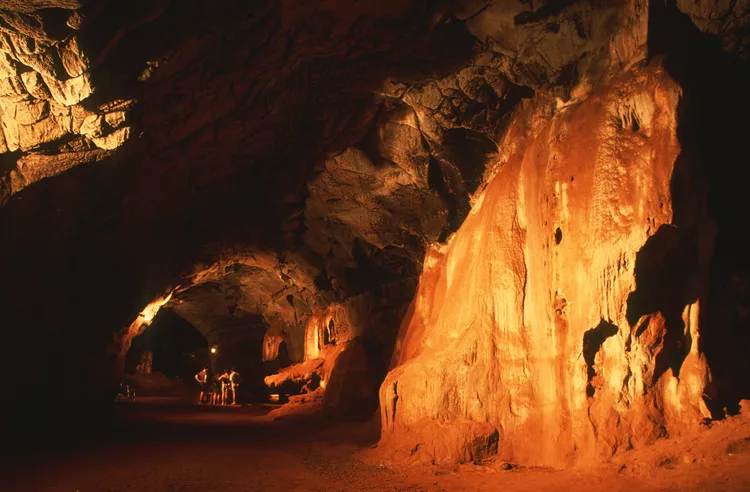Summary
South Africa is replete with remarkable natural wonders, and for visitors exploring the northern part of the country, the Sudwala Caves rank among the most impressive attractions. Carved from Precambrian rock over 240 million years ago, this cave system is considered one of the oldest on Earth. Located just a 30-minute drive from the city of Nelspruit, the Sudwala Caves have gained fame as a must-visit destination in Mpumalanga Province.
How the Caves Were Formed
The Sudwala Caves are sculpted from the Malmani Dolomite Ridge, which is a component of the renowned Drakensberg escarpment. The ridge itself dates back to the Precambrian period, making the surrounding rocks approximately 3,000 million years old. However, the caves began forming later, around 240 million years ago. This origin predates the existence of Africa, highlighting the remarkable antiquity of Sudwala.
The cave system displays classic Karst topography, providing insight into its formation. Over the course of hundreds of thousands of years, acidic, carbon dioxide-rich rainwater percolated through the porous dolomite rock. This continuous process gradually dissolved calcium carbonate, ultimately widening natural fissures and fractures within the rock.
Consequently, these weaknesses evolved into interconnected caves and caverns, forming the complex we recognize today. Initially, the caves were filled with water, which dripped from the ceilings, leading to the creation of mesmerizing rock formations such as stalactites, stalagmites, columns, and pillars.
Human History
Archaeological evidence suggests that the Sudwala Caves were once inhabited by prehistoric humans. Tools dating back approximately 2.5 million years ago to a few thousand years BC can be found displayed at the cave entrance.
In more recent history, the caves offered refuge to a Swazi prince named Somquba. Forced to flee from Swaziland in the late 19th century after a futile attempt to usurp his brother Mswati’s throne, Somquba continued leading his men into South Africa for raids and cattle theft. The spoils from these incursions were reportedly cached at Sudwala, and the caves served as a stronghold due to the readily available water and their defensible structure.
The caves derive their name from Somquba’s chief advisor and captain, Sudwala, who often managed the fortress. Local lore contends that Sudwala’s ghost still roams the cave system. Additionally, during the Second Boer War, a stash of gold bullion belonging to the Transvaal Republic vanished while being transported for safekeeping. Many speculate that this treasure remains hidden within the Sudwala Caves, although numerous treasure hunts have proven fruitless.
The Caves Today
In 1965, Philippus Rudolf Owen from Pretoria purchased the caves and subsequently opened them to the public. Nowadays, visitors can immerse themselves in the intriguing geological and human history on a one-hour guided tour that spans 600 meters into the cave system and descends approximately 150 meters underground. The walkways, illuminated by colorful lights, accentuate the caves’ most captivating formations. Tours are frequently scheduled, with a maximum waiting period of 15 minutes upon arrival.
For those seeking adventure, the Crystal Tour occurs on the first Saturday of every month. This tour delves 2,000 meters into the cave system, leading to a chamber filled with shimmering aragonite crystals. However, this experience is not for everyone; it involves navigating through waist-deep water and cramped tunnels. Age and weight restrictions apply, making it unsuitable for individuals with claustrophobia or back and knee complications. Moreover, this specialized tour requires several weeks’ advance planning.
Things to See
A visit to the Sudwala Caves wouldn’t be complete without exploring the magnificent Amphitheatre, a large chamber that measures 70 meters in diameter and rises 37 meters to a stunning domed ceiling. Other significant formations include Samson’s Pillar, the Screaming Monster, and the Rocket, with the oldest of these dating back 200 million years. While wandering through the caves, keep an eye out for fossils belonging to the primitive plant genus Collenia. Additionally, the ceilings house a colony of over 800 insectivorous horseshoe bats.
While awaiting your tour, be sure to explore the prehistoric artifacts showcased at the entrance. Following that, you might continue your adventure at the on-site Fish Spa, or consider visiting the Sudwala Dinosaur Park. Located just 100 meters away, this popular attraction features life-sized representations of prehistoric creatures set amid a lush tropical garden. Keep an eye out for monkeys and exotic birds that roam freely, along with a display of live Nile crocodiles that celebrate the reptiles’ ancient lineage.
How to Visit the Sudwala Caves
The Sudwala Caves can be found along the R539 road, conveniently connecting to the main N4 at intersections located north and south of Nelspruit, the capital city of Mpumalanga Province. It is a 3.5-hour drive from Kruger National Park, making it an ideal detour for travelers heading to Johannesburg by road. The caves are open every day from 8:30 a.m. to 4:30 p.m. Admission prices are:
- R100 per adult
- R80 per pensioner
- R55 per child (under 16)
- Free for children under 4
The Crystal Tour is priced at R450 per person, requiring a 50% advance deposit. If you desire to partake in this tour outside the designated first Saturday schedule, arrangements can be made for a separate tour for groups of five or more.
For accommodations, options such as Sudwala Lodge and Pierre’s Mountain Inn are recommended. Sudwala Lodge lies a mere five-minute drive from the caves, offering a variety of family-friendly rooms and self-catering chalets set in a scenic garden complete with a swimming pool. Pierre’s Mountain Inn presents 3-star en suite rooms and a restaurant within walking distance of the cave entrance.




